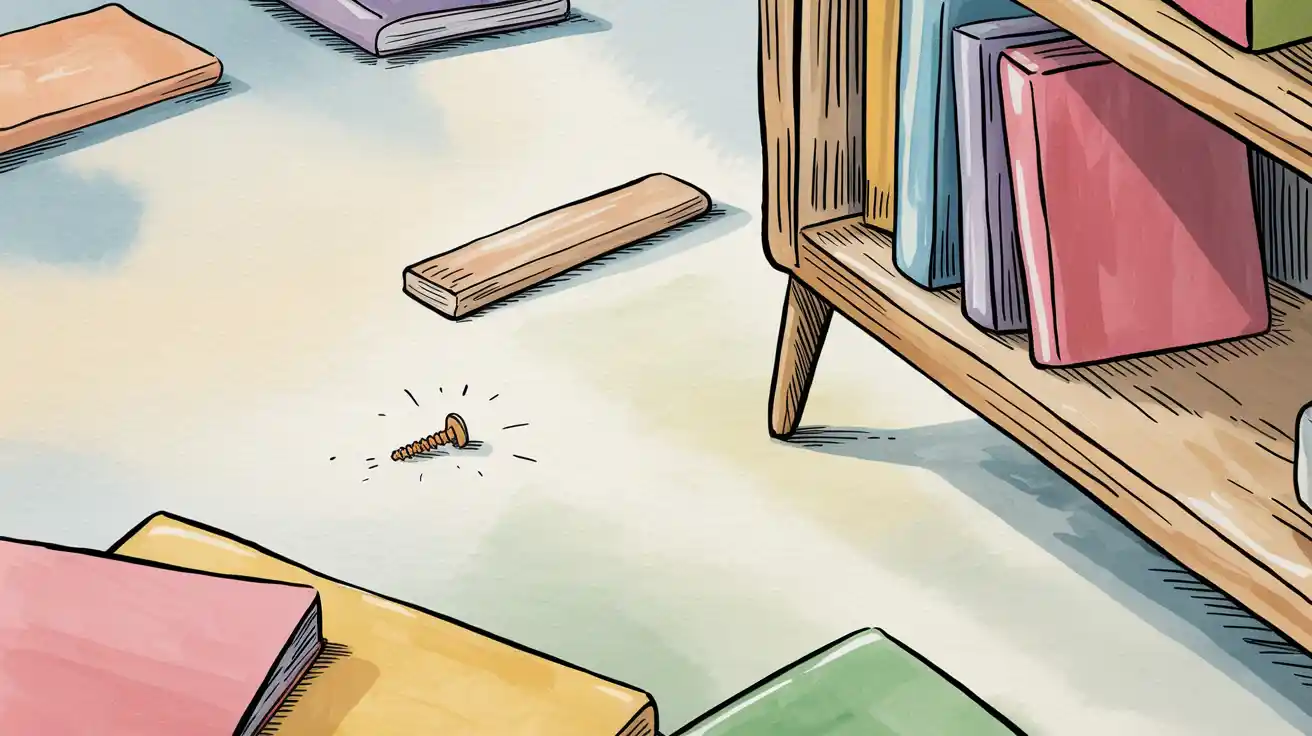I Tried to Build a Bookshelf. It Ended in Tears (and a Single, Ominous Screw).

In the official instruction manual for reinventing your life, there’s a chapter that’s conspicuously missing.
It’s the one that comes right after “Follow Your Bliss” and just before “Live Your Best Life.” It’s the chapter on spectacular, humiliating, sawdust-covered failure.
I know it’s missing because I went looking for it on the day I tried to build a Scandinavian bookshelf with nothing but a tiny Allen key and a dangerously high level of self-confidence.
After the dramatic demise of my fern, Felicia, I was a woman on a mission.
The old me, the one who let plants wilt in a “perfect” apartment, was gone. The new me was going to be capable. She was going to be a doer, a builder, a woman who could wrestle her life into shape with her own two hands.
My first act of defiance against my old, passive self? To purchase the KÄLLESTAD, a bookshelf so sleek and minimalist it seemed to promise a new, organized life just by existing in my living room. It was more than a bookshelf; it was a metaphor.
What followed was a masterclass in embracing failure when starting over. It was a lesson in humility, spatial reasoning, and the quiet tyranny of wordless instructions.
A Brief Word on Hubris and Pictograms
The box arrived with a reassuring thud. It was heavy with possibility. I laid out all the pieces on my living room floor, a sea of particleboard and a small, intimidating bag of screws, dowels, and cam locks.
The instruction manual contained no words, only a series of pictograms featuring a cheerful, gender-neutral cartoon person who assembled the entire bookshelf with a serene smile and what appeared to be zero difficulty. “I can do this,” I thought. “The cartoon person believes in me.”
The first mistake was my unearned swagger.
The second was discovering that Panel C looks almost identical to Panel G, except for one tiny, strategically placed hole that you won’t notice is missing until you are seven steps ahead.
The gentle cartoon person on the page offered no warnings. He just kept smiling, holding his perfectly angled screwdriver, blissfully unaware of the quiet chaos unfolding in my apartment.
I hammered dowels into the wrong holes. I screwed things up backwards. At one point, I attached a shelf with such conviction that I had to spend twenty minutes surgically removing it, leaving behind a wound of splintered particleboard.
The sleek, minimalist dream was slowly morphing into a wobbly, structurally unsound monument to my own incompetence. My new life was already a fixer-upper.
The Messy Middle is Covered in Sawdust
We love a good transformation story, but we’re obsessed with the before and after photos. We conveniently edit out the part in the middle, the long, awkward, and often frustrating phase of actually doing the work.
This is the messy middle of change, and it’s where most of us get stuck. It’s the part where you’ve left the safety of who you were but haven’t yet become who you want to be.
The messy middle is not glamorous. It’s sitting on your floor, surrounded by the wreckage of your own good intentions, wondering if it would be easier to just burn everything and start over in a new city under an assumed name.
It’s the gap between the vision in your head and the wobbly reality in front of you. This is the moment that tests your resolve.
The temptation is to quit. To shove all the pieces back in the box and pretend it never happened. But the secret to navigating this phase is radical self-acceptance. It’s about giving yourself the permission to be a beginner. Being a beginner is humbling. It means accepting that you will be bad at things for a while.
You will make mistakes. You will, on occasion, build a bookshelf that leans at a jaunty, alarming angle. And that has to be okay. It’s a perfect, textbook example of how to handle embarrassing mistakes: you have to learn to sit in the mess.
Laughter, Leftover Screws, and Letting Go
The climax of my DIY disaster came when I tried to stand the bookshelf up. I lifted it with a grunt, and it swayed with the structural integrity of a house of cards in a hurricane.
Then, with a soft, splintering sigh, the main vertical panel cracked, and the whole thing slumped sideways into a sad, defeated heap.
I stood there, staring at the carnage. And then I saw it, lying innocently on the floor next to the Allen key: a single, leftover screw. It was the screw of doubt. The screw of failure. The screw that proved I had done it all wrong.
And in that moment, staring at the leftover screw and the collapsed bookshelf, something shifted. The initial wave of frustration gave way to a ripple of the absurd. It was, when you thought about it, deeply, profoundly funny.
I had tried to build my new, free, authentic life by rigidly following a set of confusing, pre-approved instructions. The universe had responded by handing me a pile of broken particleboard.
This is a core tenet in the art of unbecoming. You have to learn to laugh at your own messy first drafts. Failure isn’t the opposite of success; it’s a necessary ingredient. It’s the data you collect on your way to getting it right. My data, in this case, was clear: maybe my new life didn’t need to come from a box with a set of instructions.
That feeling of sitting in the private wreckage of your own good intentions was exactly what I wanted to explore with my character Everly in Her Last Filter, but on a massive, public scale.
Her own reinvention story begins with a disastrous, public failure that goes viral.
Because the most important growth often comes right after we’ve fallen flat on our face. It’s in that moment, when you’re at your most humbled, that you’re finally open enough to learn a new way of building.
I eventually took the bookshelf apart, piece by splintered piece, and put it out with the recycling. It was a failure, but it was an honest one.
And it taught me more than a perfectly assembled piece of furniture ever could. It taught me that starting over isn’t about following a plan. It’s about being willing to sit in the mess, laugh at the chaos, and figure out what to do with all the leftover screws.
What’s your most memorable “DIY disaster” moment? I’d love to hear about a time you tried to build, bake, or create something new and it went spectacularly wrong. Share your story in the comments!


